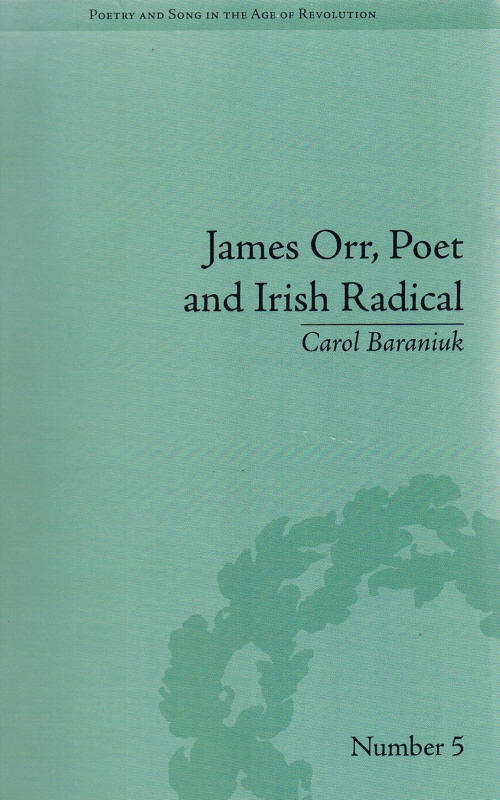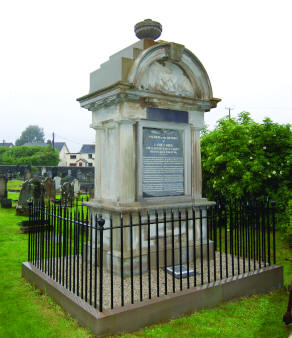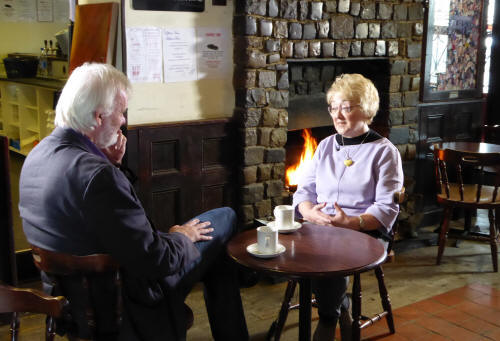|
Edited by Frank R. Shaw, FSA Scot, Greater Atlanta, GA, USA
Email: jurascot@earthlink.net
Some books are a bit difficult to read for a
variety of reasons, but the publication in today’s review is not in that
category. It is most certainly a keeper. Don’t make the mistake of
thinking it’s only the story of a radical Irish poet. Robert Burns
figures in this book with many references throughout its pages. Author
Carol Baraniuk has written an outstanding book on James Orr, Poet and
Irish Radical, that is most enjoyable. As the book cover reveals, it
concerns “Poetry and Song in the Age of Revolution”.
There are many people in Scotland I have grown close to over the years
and “family” seems to be the best word to describe our relationships.
Carol is one of those people. I met her years ago while attending a
Robert Burns Conference at the University of Glasgow’s Centre for Robert
Burns Studies. We sat across from each other in a restaurant close to
campus at the end of the day’s conference. As I recall, it was a large
table since there were so many of us, and I do remember the restaurant
being full of patrons and the conversations and music were very noisy.
It was a Saturday night and everyone was evidently celebrating the end
of another work week. I do not remember what I had to eat, but I
certainly remember my conversation with Carol about all things Scottish.
She is a lovely person and it does not take long to get to know her as
she is right at home with anyone she meets. She is, by the way, the aunt
of Jennifer Orr whose own book was reviewed in these pages sometime back
(see Chapter 138 in our index) and I might add that Jennifer has
recently published another book that I will review in the near future.
Writing must run through the veins of this talented and scholarly
family!
I hope you take time to read the brief review of Carol’s book below and
find something new about the times in which Burns lived, loved, and
wrote as those in Ireland followed his career as much as the people did
in his own little town or countryside. There is much more between the
Irish writers and Burns than many current Burnsians know. Carol gives us
the opportunity to obtain a new perspective on Burns and read what they
were writing and saying about him in Ireland. Several of them made trips
to his Scottish home to have meetings with him, and some knew his
favorite pubs and waited there to converse with him. His Irish
contemporaries looked up to him and sought him out for advice which they
took back home to share with their fellow writers. These Irish writers
have more to offer about Burns than some throughout Scotland, the United
States or other countries. This book is worth the journey from page one
through 238. Saddle up, hold on and enjoy a good ride. Your time in this
book will be well rewarded…it is that good!
James Orr, Poet and Irish Radical
By Dr. Carol Baraniuk

This is the story of James Orr (1770-1816),
a preacher man, a fighter, and a poet who once before was nearly
forgotten but is remembered today as a top notch Irish poet. Dr.
Baraniuk has given us a special book and it always tickles me to find
that Robert Burns can turn up in the most unusual places. This is
another publication that has proven to also have many references to
Robert Burns. Were these Irish poets copying Burns, imitating him, or
trying to follow the path of writing Burns chose? John Hewitt wrote
regarding the Ulster Scots poets that they “were no more imitators of
Burns than Burns himself was of earlier Scottish masters”. Hewitt passed
away in 1987 and this has yet to be been refuted, challenged, or proven
false as far as I can tell.
I will say again, this is a special book
about poets and radicals in Ireland, but along the way we find that it
is much more. It is a scholarly book written in a way the man in the
street, also known as the common man whom Burns reached out to in his
day, should find to his liking in today’s world. Thank Carol for that
since she has the talent to write for the scholar and the common man by
making her writing easier to comprehend no matter which part of the
city, town, village or county you live in, be it Scotland, Ireland,
England, Europe or America. We must remember the man himself, Robert
Burns, prophesized the extent of his own popularity a hundred years
after his death. Carol paints with a broad brush for the majority of her
readers to grasp and not just a narrow one for the highly educated.

James Orr’s monument, Templecorran Cemetery,
Ballycarry.
Photograph by author Carol Baraniuk
The two big experiences of Orr’s life found
him caught up in rebellion and soon after slipping away to America into
exile. According to Dr. Baraniuk, the articles about Orr while he was
banished to America “tended to focus on his United Irish involvement,
his honest character, his concern for the poor, his personal
attractiveness, and the regrettable descent into alcoholism which may
have brought about his premature death”. I must say that for me the most
important thing Carol stresses in no uncertain terms is “this study
argues that Orr must not be interpreted as Burns-dependent”. She has
proven this point of study to me! Thanks, Carol, dear friend, for the
opportunity to review your very special book!

Carol being interviewed for a BBC
documentary about Ulster-Scots Literature and Language which aired just
over a week ago. The setting is the pub in Ballycarry village - the same
one that was there in Orr's lifetime, and where he met regularly with
his Masonic Lodge.
If there is a complaint to be made about this book, and let me make it
clear that this is in no way the writer’s fault, it belongs to the
publisher who chose to use a font that is time consuming to read to say
the least. Why? Maybe it was to use fewer pages in the book in order to
bring down costs; only they can say. I remember reading as a high school
student that an American automobile company eliminated one piece of
exterior decoration on one of their cars to save the company $5 per
vehicle. That’s not much. Yet they were planning to produce a million
cars so you can do the math! Five million dollars is nothing to sneeze
about. But do not let this deter you about the book, its subject, and
the many things mentioned regarding Burns from an Irish point-of-view.
The book has a wealth of Burns and Irish knowledge waiting for you and
is one for the Irish and Scottish lovers of the Bard worldwide.
(FRS: Thanksgiving Eve, 11.25.15)
|

